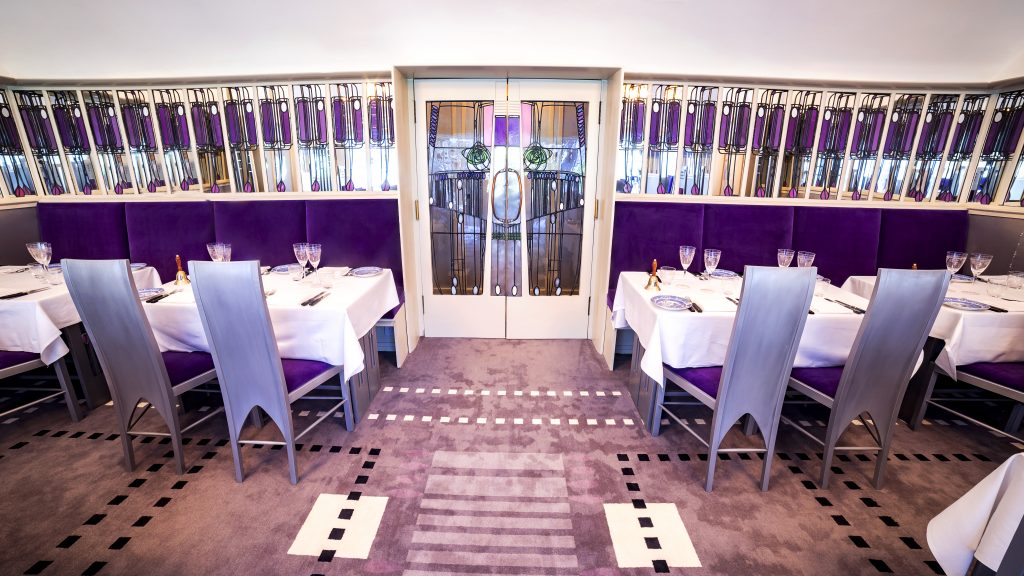
Mackintosh at the Willow A Wee History! Part 3.
This week one of our lovely followers has asked for some more information on Margaret Macdonald Mackintosh’s gesso panel, situated in the Salon de Luxe. Here we go!
On the first floor of Mackintosh at the Willow, guests can find the Salon de Luxe. Aptly named for its opulent furnishings and rich décor, the Salon de Luxe is an intimate space full of glittering mirrors, silk dados and purple velvet. The room is arguably one of Mackintosh’s most extravagant and is said to have been designed in creative partnership with Margaret Macdonald Mackintosh. One of the most distinctive features of the Salon de Luxe is undoubtedly the gesso panel O Ye, All Ye Who Walk in Willowwood by Macdonald Mackintosh.
The original panel was commissioned by Miss Catherine Cranston in 1903 and now resides in the Kelvingrove Art Gallery and Museum in Glasgow’s West End. The gesso on display at Mackintosh at the Willow is an immaculate replica, created especially for us by the incredibly talented Dai and Jenny Vaughn of Vaughn Arts.
As mentioned in the previous blog, the title of the gesso, was taken from the first line of the first of Dante Gabriel Rossetti’s four ‘Willowwood’ sonnets and is illustrative narrative of the poem itself. The poem contains three main characters: the poet, lost love and love itself both personified.
I sat with Love upon a woodside well,
Leaning across the water, I and he;
The certain secret thing he had to tell:
Macdonald Mackintosh reflects the symbolic nature of the sonnet through her visual depiction, mirroring the ways in which Rosetti fragments his prose to emphasise specific elements important to the theme. The artist mirrors this use of iconography in several ways.
The green oval shape in the centre is representative of the well. Wells were traditionally symbolic of meeting places and water holes – much like a tearoom.
We can determine that the three figures in the gesso are all depicting Lost Love in various tones as she walks through the woods. The poet’s eyes fill with tears as he thinks of his Love, the tears fall in to the well disturbing the water and her likeness appears on its surface. Whether, in this fantastical atmosphere, this is the representation of his love, her true face or symbolic of her memory is uncertain. What is certain is the mood of the poem, which is one of longing and melancholy with undertones of deep sensuality.
Only our mirrored eyes met silently In the low wave; and that sound came to be
The passionate voice I knew; and my tears fell.
He swept the spring that watered my heart’s drouth.
Then the dark ripples spread to waving hair
A disembodied hand floats in the centre of the well, touching the surface of the water which ripples and creates the shape of a rose, a symbol of love. The connection of the hand and the rose, and their consequential proximity to the lips of one of the portrayals of lost love represent the meeting of lips described in Dante’s sonnet.
And as I stooped, her own lips rising there
Bubbled with brimming kisses at my mouth.
The Salon de Luxe is lined with leaded glass mirrored panelling that surrounds the entire room, giving it an ethereal quality. As mentioned in our previous blog, as one moves through the room the reflection of your person is duplicated across all four walls. This makes it look as though someone is running through trees, just out of sight as you can just see this reflection in your peripheral vision.
This is a feature of the Gesamtkunstwerk that truly transforms a beautiful room into a fantastical experience. The mirrors extend the visual narrative of the gesso, creating an extended wooded area, turning the Salon de Luxe into a glittering forest. This dreamy experience is mesmerizing and must have been awe inspiring for its 1903 audience.
And now Love sang:
And I was made aware of a dumb throng
That stood aloof, one form by every tree,
They looked on us, and knew us and were known;
So when the song died did the kiss unclose;
And her face fell back drowned, and was as grey
As its grey eyes;
Her breath and all her tears and all her soul:
And as I leaned, I know I felt Love’s face
And so, the poet lets his love go and she washes away with his tears fading from his touch and dissolving with the water. The contrast of the life-giving water and this drowned, grey, corpse like figure is startling and moving at the same time, reminding the viewer of the grief of lost love.
It is interesting to note here that this is not the only tragic love story told at Mackintosh at the Willow. The blue and white willow china also holds a story of love, sacrifice and the soul within its pattern – something we will touch upon in another post.
The various components of the image are drawn together by the beaded, flowing lines that drape over the figures. They are reminiscent of those weeping willow branches, holding their catkins like pearls and creating a veil over the figures. This emphasises the mystical aspects of the figures depicted and parallels the overriding theme of the willow its branches as a binding design features throughout the building. The guest is just as much part of this story as these enigmatic figures.
This article references the work of Dr Robyne Calvert.
See her article “A walk in Willowwood: Decoding the ‘Willowwoods’ of Dante Gabriel Rossetti and Margaret Macdonald Mackintosh” here: Calvert-Willowwood.pdf
Read the blog version: Here
See Dai and Jenny Vaghaun talk about the recreation process below





